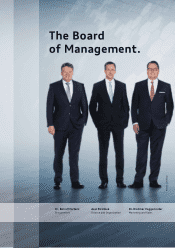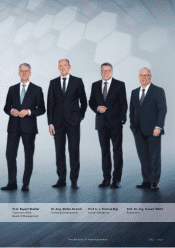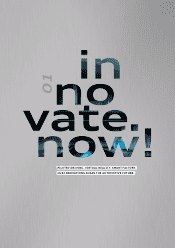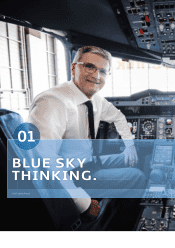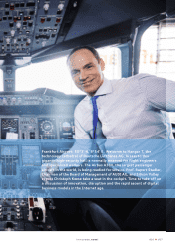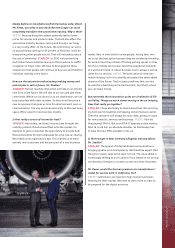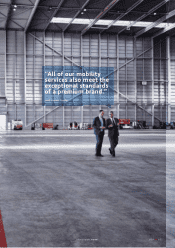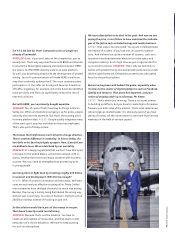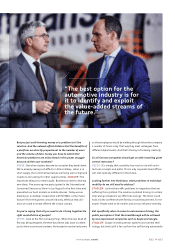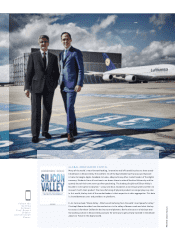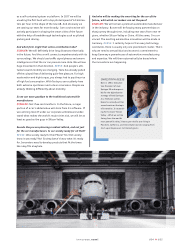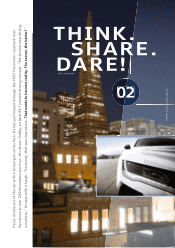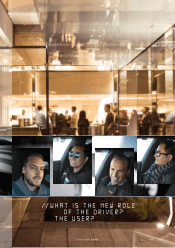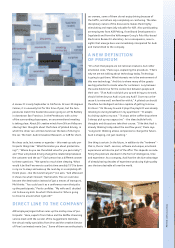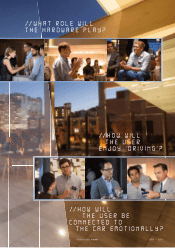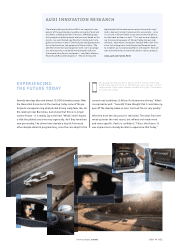Audi 2015 Annual Report Download - page 22
Download and view the complete annual report
Please find page 22 of the 2015 Audi annual report below. You can navigate through the pages in the report by either clicking on the pages listed below, or by using the keyword search tool below to find specific information within the annual report.
Isn’t it a bit late for that ? Companies such as Google are
already all-powerful.
STADLER :
Look, if you don’t take on the competition, you’ve
already lost. That’s why we joined forces with BMW and Daimler
to acquire the Nokia digital mapping and location business HERE.
Our goal is to o er HERE industry-wide as an open platform.
So we’ll also be pressing ahead with the development of piloted
driving. Car-to-X communication will make HERE a real-time
map that constantly updates itself. The more communicators
participate in it, the safer car driving will become.
A build-up
of tra c congestion, for example, will in the future be identifi ed
more precisely, and that can signifi cantly reduce the risk of
rear-end collisions.
But with HERE, you’ve primarily bought expertise.
STADLER : Yes, of course ! That’s how they do things in Silicon
Valley, too. When an interesting company is up for grabs, people
naturally also want its expertise. But that’s the starting point
for every platform idea. KEESE : Google quickly integrates many
of the start-ups it acquires and takes on their top employees.
That’s also part of Valley culture.
That shows that Californians aren’t afraid to change direction.
There’s another di erence in mentality : In Silicon Valley, if a
hero falls on his face he just gets up again. Here, if you fail you
are dubbed a loser. We are held back by our mentality.
STADLER : It’s deeply regrettable that we don’t have that spirit
in Europe. In the United States, universities network with in-
dustry, develop businesses and equip students with business
acumen. We, too, need to strengthen that pioneering spirit
in young people.
Germany plans to fi ght back by investing roughly € billion
in research and development. Will that be enough ?
KEESE : When it comes to innovation and education, half-mea-
sures are not nearly as e ective as going all-in. Many Califor-
nian companies have changed the world on much less money.
Besides, the money is simply being distributed the wrong way.
And not just in Germany. As a result, Europe is trying to set up
Silicon Valleys instead of focusing on just one.
So the solution would be to put all the money in one pot.
That doesn’t exactly sound revolutionary.
STADLER : Because that’s not the solution. You have to
create an atmosphere of innovation, and that starts in the
early years of a child’s education. We have to keep pushing
for such an atmosphere.
We have often failed to do that in the past. And now we are
paying the price, in our failure to have mastered the technolo-
gies of the future such as biotechnology and mobile business.
KEESE : That view is too one-sided. You mustn’t underestimate
the impact of clusters. If you lose one, it’s gone for genera-
tions. And we have lost quite a number of clusters, such as in
household and entertainment electronics or the optics and
computer industry. So it’s high time we put a regional slant to
our economic policies. STADLER : That’s why we took the ini-
tiative with piloted driving and worked with politicians to estab-
lish the right framework. Entrepreneurs need to be a disruptive
force for the political sphere.
But we’ve long been well behind the game, especially when
it comes to the cluster of digital platforms such as Facebook,
Spotify and Amazon. That plane has departed, and your
notion of playing catch-up is a fantasy, Mr. Keese.
KEESE : That’s where you’re wrong. There is no secret science
to building a platform, but you have to create high information
frequency on both sides of the market – that’s what determines
who emerges as market leader. It’s obviously easier if you have
plenty of money. All the more reason to overcome that German
weakness in the fi eld of venture capital.
PHOTOS : Dieter Roosen


